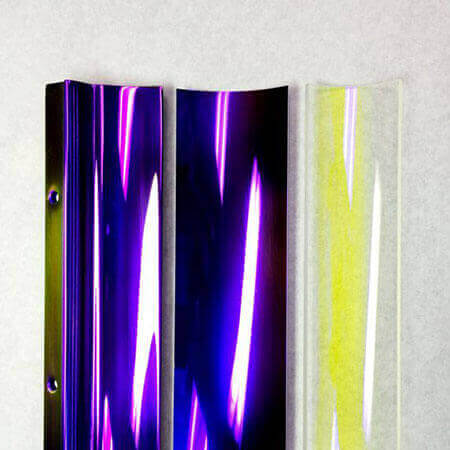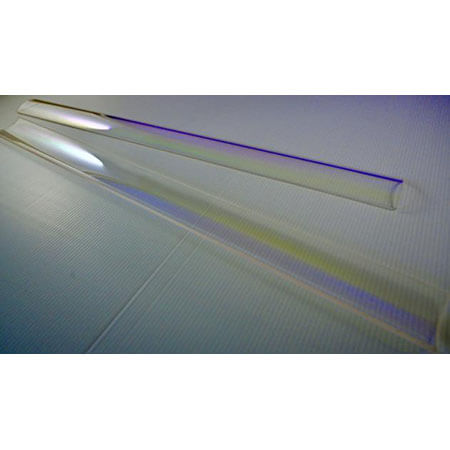UV Reflector are critical components in UV curing systems, designed to maximize the efficiency of UV lamps by reflecting UV light towards the substrate. These reflectors are essential for achieving uniform curing in applications such as printing, coating, and adhesive bonding.
We are utilized in multiple industries where precision UV curing is necessary. They are commonly found in printing presses, nail salons for curing nail polish, and in the manufacturing of electronics where they aid in the curing of conformal coatings on circuit boards.
We are utilized in multiple industries where precision UV curing is necessary. They are commonly found in printing presses, nail salons for curing nail polish, and in the manufacturing of electronics where they aid in the curing of conformal coatings on circuit boards.
UV Reflector
UV Curved Dichroic Coating Reflectors/Cold Mirrors
GCTC’s aluminum and cold mirror reflectors are suitable for standard UV systems for which substrate to use is depending on the characteristics of the working piece; Cold-mirror reflectors are using for heat-sensitive materials as they absorb heat-producing infra-red energy and reflects only the UV energy.
UV Curved Quartz Dichroic Reflectors
UV cold mirrors reflect UV energy while removing heat-producing visible and infrared energy. The removal of visible and infrared energy can be accomplished by transmitting the visible and infrared energy through the reflecting optic (typically fused silica) or by absorbing the visible and infrared energy and transferring the absorbed heat to the reflecting optic (typically aluminum). UV cold mirrors are extremely effective at increasing the amount of reflected UV energy at the irradiation zone while simultaneously significantly reducing the visible and infrared energy. The result is lower temperatures at the irradiation zone, allowing the processing of temperature sensitive substrates.
Cold mirrors are useful in protecting temperature sensitive substrates. Uses include
Photo polymerization of inks, dyes and adhesives
Semiconductor manufacture
Printed circuit board manufacture
Product packaging
Flooring
Water sterilization
Imaging
Curved Cold Mirror (Reflector)
Dichroic film coating glass reflector
Spectral characteristics:
Reflecting avg. ≧92% for spectrum range at 220~400Nm
Transmission avg. ≧ 80% for spectrum range at 450~2000Nm
The reflectors we produce help reflect the ultraviolet curing energy and pass infrared wavelengths. This is achieved by reflecting visible light. Less infrared radiation means less heating of the illuminated object in the beam. Dichroic reflectors are used in compatible lamps to help the system dissipate heat and thereby extend the life of the lamp.
Selecting the best
Reflectivity: Choose a reflector with high UV reflectivity to ensure maximum light efficiency.
Material: Reflectors made from materials like aluminum or coated with reflective materials such as dichroic coatings offer better performance and durability.
Compatibility: Ensure the reflector fits your UV lamp system and is compatible with the wavelengths used.
Q: How often should I replace?
A: It is recommended to replace periodically, as dirt and degradation can reduce their effectiveness over time.
Q: Can be cleaned?
A: Yes, careful cleaning with appropriate solvents can help maintain reflector efficiency, but always follow the guidelines to avoid damage.
The
The manufacturing process for involves precise engineering to achieve high reflectivity and resistance to UV degradation. Quality manufacturers and suppliers use advanced materials and apply specialized coatings to enhance the performance and lifespan of these components.
Vital for maximizing the effectiveness of UV curing processes across various applications. With continuous advancements in UV technology and materials science, these components are becoming more efficient and tailored to specific industry needs.
UV Reflector
for your system involves several considerations:Reflectivity: Choose a reflector with high UV reflectivity to ensure maximum light efficiency.
Material: Reflectors made from materials like aluminum or coated with reflective materials such as dichroic coatings offer better performance and durability.
Compatibility: Ensure the reflector fits your UV lamp system and is compatible with the wavelengths used.
Q: How often should I replace?
A: It is recommended to replace periodically, as dirt and degradation can reduce their effectiveness over time.
Q: Can be cleaned?
A: Yes, careful cleaning with appropriate solvents can help maintain reflector efficiency, but always follow the guidelines to avoid damage.
The
UV Reflector
industry is currently evolving with advancements in materials and coatings that enhance reflectivity and durability. Innovations in UV LED technology are also influencing the design and application of reflectors, as these LEDs require different reflector characteristics compared to traditional UV lamps.The manufacturing process for involves precise engineering to achieve high reflectivity and resistance to UV degradation. Quality manufacturers and suppliers use advanced materials and apply specialized coatings to enhance the performance and lifespan of these components.
Vital for maximizing the effectiveness of UV curing processes across various applications. With continuous advancements in UV technology and materials science, these components are becoming more efficient and tailored to specific industry needs.
 English
English Français
Français Deutsch
Deutsch Русский
Русский Português
Português Italiano
Italiano हिन्दी
हिन्दी Español
Español Nederlandse
Nederlandse العربية
العربية Tiếng Việt
Tiếng Việt ภาษาไทย
ภาษาไทย Bahasa Indonesia
Bahasa Indonesia বাঙ্গালী
বাঙ্গালী Türk
Türk 繁體中文
繁體中文

